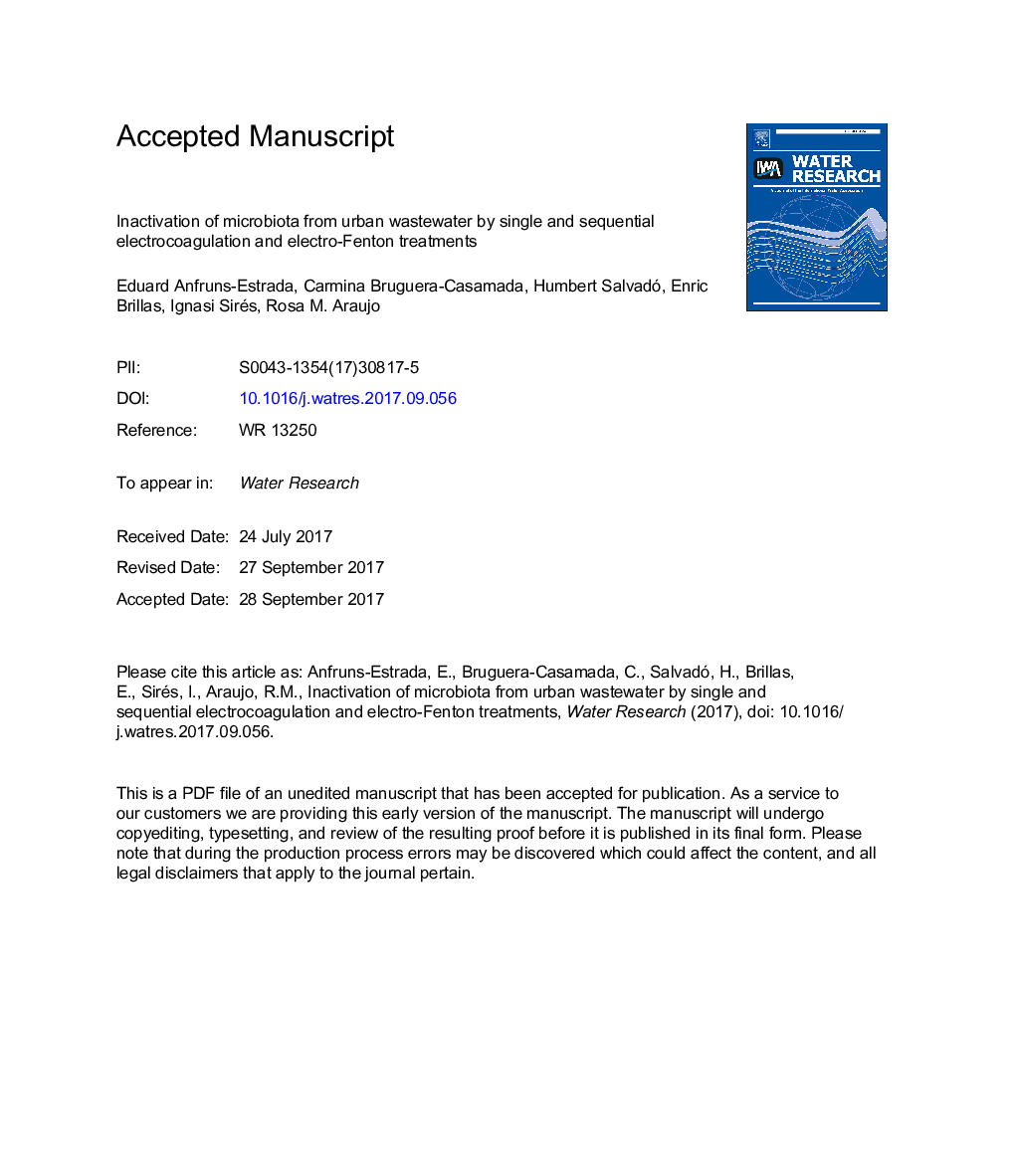| کد مقاله | کد نشریه | سال انتشار | مقاله انگلیسی | نسخه تمام متن |
|---|---|---|---|---|
| 5759272 | 1623042 | 2017 | 34 صفحه PDF | دانلود رایگان |
عنوان انگلیسی مقاله ISI
Inactivation of microbiota from urban wastewater by single and sequential electrocoagulation and electro-Fenton treatments
ترجمه فارسی عنوان
غیر فعال کردن میکروبیوتا از فاضلاب شهری با استفاده از الکتروکواگولاتور تک و متوالی و درمان الکترو فنتون
دانلود مقاله + سفارش ترجمه
دانلود مقاله ISI انگلیسی
رایگان برای ایرانیان
کلمات کلیدی
باکتری شاخص، ضدعفونی الکتروشیمیایی، الکترو کلاژن، الکترو فنتون، درمان تصادفی فاضلاب شهری،
موضوعات مرتبط
مهندسی و علوم پایه
علوم زمین و سیارات
فرآیندهای سطح زمین
چکیده انگلیسی
This work aims at comparing the ability of two kinds of electrochemical technologies, namely electrocoagulation (EC) and electro-Fenton (EF), to disinfect primary and secondary effluents from municipal wastewater treatment plants. Heterotrophic bacteria, Escherichia coli, enterococci, Clostridium perfringens spores, somatic coliphages and eukaryotes (amoebae, flagellates, ciliates and metazoa) were tested as indicator microorganisms. EC with an Fe/Fe cell at 200 A mâ2 and natural pH allowed >5 log unit removal of E. coli and final concentration below 1 bacteria mLâ1 of coliphages and eukaryotes from both effluents in ca. 60 min, whereas heterotrophic bacteria, enterococci and spores were more resistant. A larger removal was obtained for the primary effluent, probably because the flocs remove higher amount of total organic carbon (TOC), entrapping more easily the microbiota. EF with a boron-doped diamond (BDD) anode and an air-diffusion cathode that produces H2O2 on site was first performed at pH 3.0, with large or even total inactivation of microorganisms within 30 min. A more effective microorganism removal was attained as compared to EC thanks to
- OH formed from Fenton's reaction. A quicker disinfection was observed for the secondary effluent owing to its lower TOC content, allowing the attack of greater quantities of electrogenerated oxidants on microorganisms. Wastewater disinfection by EF was also feasible at natural pH (â¼7), showing similar abatement of active microorganisms as a result of the synergistic action of generated oxidants like active chlorine and coagulation with iron hydroxides. A sequential EC/EF treatment (30Â min each) was more effective for a combined decontamination and disinfection of urban wastewater.
- OH formed from Fenton's reaction. A quicker disinfection was observed for the secondary effluent owing to its lower TOC content, allowing the attack of greater quantities of electrogenerated oxidants on microorganisms. Wastewater disinfection by EF was also feasible at natural pH (â¼7), showing similar abatement of active microorganisms as a result of the synergistic action of generated oxidants like active chlorine and coagulation with iron hydroxides. A sequential EC/EF treatment (30Â min each) was more effective for a combined decontamination and disinfection of urban wastewater.
ناشر
Database: Elsevier - ScienceDirect (ساینس دایرکت)
Journal: Water Research - Volume 126, 1 December 2017, Pages 450-459
Journal: Water Research - Volume 126, 1 December 2017, Pages 450-459
نویسندگان
Eduard Anfruns-Estrada, Carmina Bruguera-Casamada, Humbert Salvadó, Enric Brillas, Ignasi Sirés, Rosa M. Araujo,
